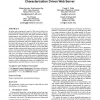Free Online Productivity Tools
i2Speak
i2Symbol
i2OCR
iTex2Img
iWeb2Print
iWeb2Shot
i2Type
iPdf2Split
iPdf2Merge
i2Bopomofo
i2Arabic
i2Style
i2Image
i2PDF
iLatex2Rtf
Sci2ools
WWW
2003
ACM
2003
ACM
Design, implementation, and evaluation of a client characterization driven web server
In earlier work we proposed a way for a Web server to detect connectivity information about clients accessing it in order to take tailored actions for a client request. This paper describes the design, implementation, and evaluation of such a working system. A Web site has a strong incentive to reduce the `time-to-glass' to retain users who may otherwise lose interest and leave the site. We have performed a measurement study from multiple client sites around the world with various levels of connectivity to the Internet communicating with modified Apache Web servers under our control. The results show that clients can be classified in a correct and stable manner and that user-perceived latency can be reduced via tailored actions. Our measurements show that classification and determination of server actions are done without significant overhead on the Web server. We explore a variety of modified actions ranging from selecting a lower quality version of the resource to altering the ...
| Added | 22 Nov 2009 |
| Updated | 22 Nov 2009 |
| Type | Conference |
| Year | 2003 |
| Where | WWW |
| Authors | Balachander Krishnamurthy, Yin Zhang, Craig E. Wills, Kashi Venkatesh Vishwanath |
Comments (0)

